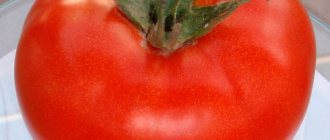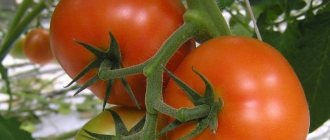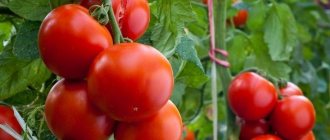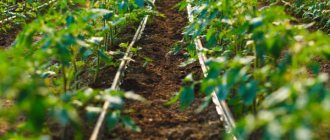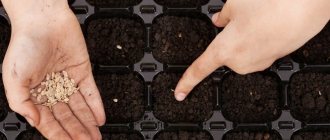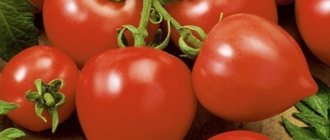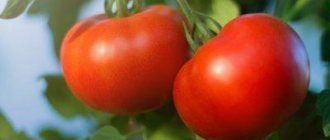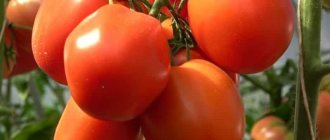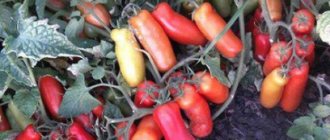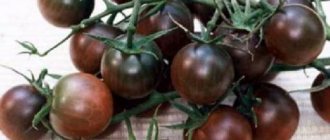The homeland of the Tanya variety is Holland, but this is not an obstacle for most Russian vegetable growers who are happy to grow the hybrid on their plots. The species has established itself as high-yielding (despite its small growth), resistant to many diseases and unpretentious in care.
The culture is ready to please gardeners with the excellent taste of vegetables, subject to regular watering and fertilizing. Many of those who have at least once planted a hybrid in their beds do not want to part with it and are looking forward to the next season to again take care of their beloved guest from distant Holland.
Description of the variety
Developed in Holland by Seminis Vegetable Seeds. Recommended for cultivation in open ground, although it also grows well in closed structures . The Russian tomato variety Tatyana is very similar to its Dutch namesake, it is practically its analogue.
A mid-season hybrid, 110–120 days pass from the moment of germination to full maturity .
The bush is determinate, standard, low-growing, compact . Height up to 65 cm. Leaves are large, dark green. The inflorescences are simple, the first inflorescence is formed above 6-7 leaves, the subsequent ones - every 1-2 leaves.
Reference! Standard tomatoes, having reached a certain height and throwing out 5-6 trusses, grow and stop growing.
The productivity is high, up to 5 kg of fruits are harvested from 1 bush , provided that 4-5 seedlings are planted per 1 sq. m.
Resistant to diseases of the nightshade family, such as : late blight, gray spot, alternaria, verticillium wilt.
The hybrid does not require pinching, but staking of low-growing bushes is required , since the branches, densely strewn with fruits, cannot support their weight.
The fruits are medium-sized, weighing 150-170 g, round in shape, bright red in color, thick skin . The taste is sweet and they are rich in vitamins, especially vitamin C.
Universal in use, suitable for fresh consumption, for winter preparations and for preparing tomato products . Excellent taste retention in pickles and marinades.
Ripe vegetables can be stored for a long time and can withstand transportation over long distances without losing their appearance or taste.
The photo shows tomato Tanya f1.
Read about other tomato varieties:
Tomato "Japanese brush" and its benefits
Tomato Em Champion: characteristics and description of the variety
Tomato "Japanese crab" that will not leave anyone indifferent
Description of tomato Tanya
The tomato variety Tanya F1 is a hybrid variety. It was bred by Dutch breeders from Seminis Vegetable Seeds, which is part of the Monsanto Company, a world leader in bioresearch. The hybrid is recommended for planting in open ground, but can also be grown in greenhouses or greenhouses. This species was included in the State Plant Register in 2007.
By its type, the tomato variety Tanya is classified as determinant. The bushes reach no more than 50-60 cm in height, which allows the variety to be classified as low-growing plants, and have a powerful root system.
The tomato crown is quite thick and consists of dark green leaves. The first inflorescence is formed above the 6-7th leaf and then at intervals of 1-2 leaves. The clusters are of a transitional type - from simple to multiple-fruited, therefore they are capable of producing from 4 to 8 fruits.
The tomato variety Tanya f1 is mid-season - the first harvest can be obtained from it in 75-80 days.
Description of fruits
The fruits of the Tanya tomato variety are spherical in shape. The color of the tomatoes is pinkish-scarlet, uniform, without a green spot at the place where the stalk is attached. The weight of a mature fruit ranges from 130 to 170 g, the largest recorded tomatoes weigh about 200 g. However, their size does not decrease as the fruiting season ends.
An important advantage of the Tanya f1 tomato variety is its dense pulp, which has a rich color and pronounced taste. It contains a significant amount of dry matter and sugar. The shell is quite dense, which ensures successful transportation and storage of vegetables for a long time.
How to grow seedlings
Sowing of seeds begins 2 months before planting seedlings in the ground . The soil is first prepared, consisting of an equal amount of turf soil and humus. The prepared soil must be disinfected with boiling water or by calcination in the oven for 10 minutes. After processing, the soil is poured into planting containers. You can plant both in common wooden boxes and in individual containers: plastic glasses or peat pots.
Reference! Planting in a wooden box is the cheapest way to grow seedlings, and the most expensive is peat pots.
Before sowing, seeds, like the soil, are treated with disinfecting solutions and. The simplest and most affordable option is saline solution. Dilute 1 g of salt in 100 ml of water and place grains in it for 1 day.
Reference! Grains sown in peat pots show the highest germination rate.
The seeds are planted at a depth of 1 cm, the distance between them is 2 cm . Then they are covered with a small amount of soil and moistened with warm, settled water using a spray bottle. The containers are covered with film and left in a dark and warm room, at a temperature of 25 degrees.
After 3-4 days, the first shoots appear, after which the film is removed and the containers are moved to a lighted place . Daylight hours for seedlings should be at least 12 hours. If additional lighting is necessary, illuminate with phytolamps.
Water the seedlings as the top layer of soil dries . For irrigation, use warm, settled water, which is used to moisten the edges of the nursery using tablespoons or a shallow watering can.
Picking is carried out when 2-3 true leaves appear . If the seedlings were planted in a common box, then during picking they are planted in separate containers.
2 weeks before transplanting into the ground, seedlings begin to harden . To do this, the planting containers are taken outside and left for 2-3 hours, gradually increasing this interval to 16 hours. In parallel with daytime hardening, the temperature in the room where the seedlings are located at night is reduced to 13 degrees.
Boarding order
Tomato Tanya is grown by obtaining seedlings. Young plants are transferred to a greenhouse, greenhouse or open ground. To obtain maximum yield, it is recommended to plant tomatoes in a greenhouse. Tomatoes can be planted outdoors only in favorable climatic conditions.
Obtaining seedlings
Soil is prepared for seedlings, consisting of equal amounts of turf soil and humus. It is allowed to use purchased land intended specifically for tomatoes and other vegetable crops.
Advice! Seeds planted in peat pots or coke substrate show good germination.
Two weeks before work, the soil is subjected to heat treatment. To do this, place it in the microwave or oven and heat it for 15 minutes. It is especially important to prepare garden soil in this way.
An effective way to treat seeds of the Tanya variety is to use a saline solution. Add 1 g of salt to 100 ml of water and place the seed in the liquid for a day.
The boxes are filled with prepared soil, then furrows are made to a depth of 1 cm. Seeds are placed in them, keeping a gap of 2-3 cm. You need to pour a little soil on top, and then water the plantings.
Important! Until seedlings form, the boxes are kept in the dark.
The germination of seeds of the Tanya variety increases at an ambient temperature of 25-30 degrees. Under such conditions, seed germination begins on day 2-3.
When sprouts appear, the containers are transferred to a place where there is access to light for 12 hours. If necessary, phytolamps are installed. Plantings need to be watered when the soil dries out. It is best to use warm water for irrigation.
Transplanting into a greenhouse
Tomatoes of the Tanya variety are transferred to the greenhouse 1.5-2 months after planting. By this time, the seedlings have a height of 20 cm, several leaves and a developed root system.
Advice! 2 weeks before planting, the tomatoes are hardened on the balcony or loggia. First, they are left outside for several hours, gradually increasing this time.
Tomatoes are planted in a polycarbonate or glass greenhouse. The soil for tomatoes is dug up in the fall. It is recommended to remove the top layer of soil to avoid the spread of diseases and pests in the spring.
You can fertilize the soil with humus or compost, superphosphate and potassium sulfide. Mineral fertilizers are applied in an amount of 20 g per square meter.
A hole 20 cm deep is prepared for planting. Tomatoes of the Tanya variety are placed in rows at a distance of 0.7 m. 0.5 m is left between plants.
Another option is to plant tomatoes in a checkerboard pattern. Then two rows are formed at a distance of 0.5 m from each other.
Important! The seedlings are carefully transferred into the created holes along with a lump of earth.
The root system is covered with soil and compacted slightly. Abundant watering is required.
Planting in open ground
Growing tomatoes outdoors is not always justified, especially in cold summers and frequent rains. In the southern regions, tomatoes can be planted in open ground. The place should be illuminated by the sun and protected from the wind.
Tomato Tanya is transferred to the beds when the soil and air have warmed up well and the danger of spring frosts has passed. Dig up the soil and add humus in the fall. In the spring, it is enough to perform deep loosening.
Advice! Tomatoes of the Tanya variety are planted at intervals of 40 cm.
For planting, make shallow holes in which the root system of the plants should fit. Then it is covered with earth and compacted a little. The final stage of transplantation is watering the tomatoes.
How to grow tomatoes
After 60 days, the seedlings are ready to be transplanted into the beds . At this time, the height of the bushes is 20 cm, they have 5-7 true leaves and developed roots. The soil for tomatoes is dug up and fertilized with compost or humus. Mineral fertilizers are also applied in the amount of 20 g per 1 sq. m. m.
Planting pattern: 50 cm – distance between seedlings, 60-65 cm left between rows.
The seedlings are planted in a hole 20 cm deep, the soil is compacted and watered abundantly . It is best to replant tomatoes in the evening or in cloudy weather.
Regular watering is established 10 days after transplantation . By this time, the young bushes have finally adapted to the new conditions and are growing. Water moderately, at the root, without getting on the leaves. The variety reacts sharply to both excess moisture and its lack.
When dry, the leaves curl and the ovaries fall off, and waterlogging leads to slower growth and the spread of fungal diseases . Water 1-2 times a week, in the morning or evening, with warm, settled water.
After watering, the soil is loosened, hilled and mulched . Loosening improves the access of oxygen to the roots, so that the seedlings absorb nutrients well. Mulching the beds with straw or peat retains moisture in the beds, so the number of waterings can be reduced. In any case, you need to focus on weather conditions and soil moisture levels.
The first fertilizing is applied 2 weeks after transplantation . Use fertilizers based on phosphorus and potassium. As a rule, these are superphosphate and potassium sulfate. Phosphorus stimulates the development of plants and increases their immunity, and potassium improves the taste of fruits. Such feeding is carried out once every 10 days. During flowering, the hybrid is sprayed with a solution of boric acid, diluted 5 g per 5 liters.
FEEDING TOMATOES DURING FLOWERING!
The culture of pinching does not require, which significantly simplifies care, but it does require a mandatory garter . The shrub is low-growing, but spreading, each fruiting cluster produces 4-5 fruits, and without a garter the branches cannot support the weight of ripe vegetables. As a support, trellises are installed next to each seedling and between them a wire is pulled to which the tomato branches are tied. This way the stem grows straight and strong, and the fruits do not reach the ground.
More about tomatoes:
Review of the Ogorodnik tomato: advantages and disadvantages
A good choice even for beginner gardeners is the Mashenka tomato.
Diseases and pests
Tomato Tanya F1 is immune to the main diseases of the nightshade family, but there are cases when there is a risk of infection from other crops growing in the neighborhood. Therefore, any preventive measures will not be unnecessary, no matter how strong the immunity the crop has.
Copper sulfate is used as a preventative measure . It disinfects plants and soil, which prevents the spread of fungal diseases, such as late blight. Monitor the level of humidity in the beds, water and loosen the soil in a timely manner, and regularly inspect the plantings for the presence of insects.
Among the folk remedies against insect infestations, spraying plants with decoctions of herbs - calendula, burdock, onion - helps . Sometimes a little potassium permanganate is added to such decoctions. Also, strong-smelling plants planted next to tomatoes serve as a preventive measure.
Attention! Hanging pheromone traps protect against parasitic butterflies without causing harm to other non-pest insects.
Tomato care
The Tanya variety is quite unpretentious in care. For normal development, they require watering and periodic feeding. To increase the stability of the bush, it is tied to a support. The Tanya variety does not require pinching. Plants do not take up much space on the site, which greatly simplifies their care.
As reviews show, tomato Tanya F1 rarely gets sick. If agricultural practices are followed, the variety is not susceptible to diseases and pest attacks. For prevention, plantings are sprayed with a solution of Fitosporin.
Watering plants
The Tanya variety gives a good harvest with moderate watering. Lack of moisture causes leaves to curl and ovaries to fall off. Its excess also negatively affects plants: growth slows down and fungal diseases develop.
One bush requires 3-5 liters of water. On average, tomatoes are watered once or twice a week. After planting, the next watering is carried out after 10 days. In the future, they are guided by weather conditions and the condition of the soil in the greenhouse or in an open garden bed. The soil should remain 90% moist.
Advice! For irrigation, use warm, settled water.
Work is carried out in the morning or evening hours, when there is no direct exposure to the sun. Water should not get on the stems or tops of tomatoes; it is applied strictly at the root.
After watering, it is recommended to loosen the soil. As a result, soil breathability improves and plants absorb nutrients better. Mulching the soil with straw, compost or peat will help prevent moisture evaporation.
Fertilizer application
During the season, the Tanya variety is fed several times. After planting, 2 weeks should pass before the first feeding. During this time, the plant adapts to new conditions.
Tomatoes are fed every week. It is best to use fertilizers based on phosphorus and potassium. Phosphorus stimulates plant development, accelerates their metabolism and improves immunity. It is applied in the form of superphosphate, which is embedded in the soil. Up to 30 g of substance is taken per square meter.
Potassium improves the taste of fruits. Potassium sulfate is chosen for tomatoes. 40 g of fertilizer is dissolved in 10 liters of water, after which it is applied under the root.
Advice! During the flowering period, the Tanya F1 tomato is sprayed with a solution of boric acid (5 g per 5 liters of water), which stimulates the formation of ovaries.
Among the folk remedies, fertilizing tomatoes with ash is suitable. It is applied directly under the plants or an infusion is prepared with its help. A 10-liter bucket of hot water requires 2 liters of ash. The mixture is infused for 24 hours, after which the tomatoes are watered.
Tying tomatoes
Although the Tanya F1 tomato is low-growing, it is recommended to tie it to supports. Due to this, the plant stem is formed straight, the fruits do not fall to the ground, and plant care is simplified.
Tomatoes are tied to wooden or metal supports. In open ground, the procedure makes plants resistant to weather conditions.
For extensive plantings, trellises are installed, between which a wire is stretched at a height of 0.5 cm. The bushes must be tied to the wire.
The nuances of growing in open ground and in a greenhouse
The hybrid is recommended for breeding throughout the country . In southern regions and regions with temperate climates, tomatoes are planted in open ground. In those areas where it is cold for a long time, the crop can only take root in greenhouses.
Tomato beds are chosen in a sunny place, protected from drafts . If the summer turns out to be cool, you need to have covering material on hand. Otherwise, the prolonged influence of negative weather factors will lead to a decrease in yield.
Since tomato branches are spreading, in protected structures it is recommended to leave a larger distance between seedlings when planting to avoid crowding . Greenhouse plants are most likely to suffer from mold due to increased humidity and air temperature. Therefore, the greenhouse must be regularly ventilated to avoid fungal diseases.
Spider mites are another scourge of the greenhouse . To protect against it, ventilate the greenhouse regularly.
Characteristics of tomato variety Tanya
The Tanya tomato is a standard one and is a non-sprouting species. If the bush is grown without removing additional shoots, it produces more fruit. But, if it is necessary to obtain the earliest and largest tomatoes, partial pinching is carried out. The crop is suitable for either growing with a garter on stakes or a trellis, or spread out.
Tanya tomatoes are medium-early, low-maintenance, non-capricious, resistant to temperature fluctuations and diseases. They are grown by seedlings and direct sowing in open ground in the southern regions. Disease resistance allows you to grow an environmentally friendly crop.
Tanya tomato yield and fruiting
Tanya tomatoes are highly productive; the low-growing bush forms about 5-6 dense clusters. When grown in open ground under film covers, it produces about 3.5-5 kg of fruit per plant. Crop yields are affected by weather conditions and soil nutrition. Ripening occurs three months from the start of cultivation.
Area of application of fruits
Due to its excellent taste, the Tanya tomato variety is used for fresh consumption. The fruits are suitable for processing into tomato products: paste and juice. As well as preparations using pickling and canning methods in whole and cut form.
Resistance to diseases and pests
Tomato Tanya is highly resistant to various diseases. Early fruiting allows the crop to avoid the period of mass infection of nightshades with late blight.
Harvesting and application
Harvesting begins 2 months after planting the seedlings in the ground . Fruiting is long, ripening is gradual, not amicable.
It is not necessary to wait for vegetables to fully ripen . Unripe fruits will ripen on their own in a few days.
At a temperature of 12 degrees, the fruits are picked green; they will not be able to gain color in the beds , but they are quite capable of getting sick or rotting.
The purpose of the fruits is universal; they are used to prepare a huge number of dishes . Used fresh in salads, hot dishes, and baked goods. They do not lose their taste in pickles and marinades; small tomatoes are suitable for whole-fruit canning. The thick skin of the tomato is perfectly preserved during heat treatment. Juices, pastes and ketchup are also made from tomatoes.
Ripe vegetables are subject to long-term storage and can withstand transportation to any location without losing their taste or presentation.
Stepson issues
A detailed description of the tomato variety Tanya F1 is impossible without discussing the problem of pinching. The creators of this hybrid offer two options for working with it.
If the gardener does not have time to remove stepsons, a good harvest will grow without this procedure. But you can get larger fruits, and even in the early stages.
This can be achieved by plucking the side shoots once. The procedure takes very little time. They approach the bushes when the first brush blooms. As a rule, this moment comes soon after the tomatoes are planted in the ground, when the plants take root and begin to grow. At this time, it is necessary to remove all side shoots below the first brush, leaving small “stumps”. Stepchildren will not grow here anymore. At the same time, competitor shoots that have jumped out of the ground at the foot of the main stem are also carefully pulled out.
See also
Description of the tomato variety GS-12 f1, its characteristics and yieldRead
Numerous reviews from gardeners indicate the great effectiveness of such moderate pinching. It is not recommended to remove the stepsons growing higher up the trunk - the lion's share of the tomato harvest is formed on them. Tanya F1 tomato bushes require mandatory staking - the plants must not be allowed to bend under the weight of the harvest.
Usually only the main stem is attached to the support; sometimes the most powerful stepsons are also picked up. Individual brushes, as a rule, do not need to be tied.
Advantages and disadvantages
The review summarizes the positive characteristics of the species and notes some negative aspects. Here are the advantages of a hybrid :
- high fruiting rate;
- ease of care;
- ability to settle down in any region;
- immune to diseases;
- does not require pinching;
- excellent taste of fruits;
- marketable condition;
- long-term storage;
- long-distance transportation;
- versatility in cooking.
Negative sides:
- requires mandatory garter;
- poor tolerance to insufficient or excessive watering.
Growing
When using the greenhouse method or when growing tomatoes in a warm climate, it is best to sow the Tatyana tomato in early spring. In the conditions of the Urals, Siberia and the Far East, it is worth waiting for the average air temperature to reach about 20°C. Before sowing the seeds, they can be pre-soaked, which will speed up the germination process.
For successful germination, it is recommended to use special soil for seedlings. The seeds are moistened with water and dropped a couple of centimeters into the nursery. Do not forget about watering the tomatoes, as well as the first fertilizing with diluted fertilizer, when the plants have their first full-fledged leaves.
Landing in the ground
Grown and strengthened seedlings can be transplanted into the ground after two months. If you have a greenhouse, one month will be enough. Given the unpretentious nature of the Tatyana tomato, almost any soil is suitable for its cultivation. When transplanting into the ground, do not forget that per 1 sq. There should be no more than six plants per meter of seedlings. The soil is pre-loosened and moistened.
Tatyana tomatoes do not require pinching or tying; it is enough to remove the lowest leaves from the bushes. Tomatoes are fed 3-4 times during the summer season. Fertilizers can be both mineral (phosphorus-potassium fertilizers are best suited) and organic origin (humus, compost, manure).
You should be careful with nitrogen supplements, as they can slow down the ripening of fruits. Water the seedlings once a week; on hot days it is worth increasing watering to once every five days. It is best to water the plants early in the morning using warm water, then lightly loosen the soil.
Tatyana does not require special growing conditions, but mulching is highly recommended. It speeds up ripening by a week, increases yield by 30%, and most importantly, protects plants from the harmful effects of the external environment and pests.
Mulch can be either organic (hay, grass, pine branches) or inorganic (polyethylene, roofing felt). You can also use waste paper and cardboard for mulching. The mulch is spread evenly between the bushes at the end of May.
Tomatoes of the Tatyana variety have bred resistance to major diseases. They ripen before the main enemy of all summer residents, late blight, appears. The main pests are Colorado potato beetles, aphids, and mole crickets. To combat them, wipe tomatoes with a weak solution of ammonia.
Farmer reviews
Farmers characterize the crop as requiring a minimum investment of time and effort, but at the same time with a maximum quantitative indicator . In addition, vegetables with excellent taste suit everyone with their universal purpose. Here are the opinions of some gardeners:
Matvey, Cherepovets : “I’ve been planting a hybrid for several years now. Excellent for winter harvesting - the fruits are small and strong. The big plus is that they can be stored for several months. I use them for pickles and making tomato paste.”
Stanislav, Perm : “I plant it in open ground. I pick vegetables green. This unloads the bush to stimulate fruiting. Tomatoes last a long time, even when ripe. They go well in salads and for home canning.”
Features of cultivation
Tomato Tanya is most often grown through seedlings. Sowing of low-growing tomatoes begins later than other varieties due to their accelerated development. The seedling period lasts about 50 days. In the southern regions, under suitable conditions, seedlings are planted when 2-3 leaves develop. In colder conditions, young bushes are grown to 6-7 or from the formation of the first inflorescences.
For sowing seeds, prepare planting containers and soil. Tomatoes are grown in cassettes, cups, and general plastic containers. Seedlings develop effectively in peat and coconut tablets. Containers that are used repeatedly are disinfected before planting.
Fiber tablets are soaked to expand in size and take on a cylindrical shape.
The soil for the containers is disinfected so that the seedlings do not get fungal infections. In a common container, the seeds are placed at a small distance, in a separate container – 1-2 pieces each. Seeds are planted in moist soil without deep burial and pressed on top with a thin layer of dry soil.
Sprouts appear after 4-5 days and are immediately moved to a place with maximum lighting. Tomatoes need a 12-hour daylight hours and in low light conditions, as well as in cloudy weather, special phytolamps are used.
Important! At night, the devices for illuminating the plants are turned off.
Picking - planting into larger containers - is carried out when several true leaves appear. The plants will be kept in new containers until transplanted into open ground. Then the seedlings are arranged so that the leaves do not overlap. Water the plants using a watering can with a thin spout so that water does not get on the vegetative parts.
A week before transplanting, tomatoes are hardened so that they adapt faster to open ground. The seedlings are transferred to the ridges when positive air temperatures at night are established - above +10°C.
Important! The soil for planting must be heated to the depth of the root system, otherwise the plants will not develop.
Tanya tomatoes are placed in 3-4 pieces. per 1 sq. m. Before transplanting the plants, the wells are well watered until the water is absorbed. This soil moisture charge will improve the development of the root system. If fertilizers were not applied during general soil preparation, this is done when planting directly into the hole. The seedlings are transferred by transferring them with a ball of earth. Cover with soil, compact, and do not water for 10 days. Before the plants adapt, they are shaded.
Mineral complexes, biofertilizers, or self-prepared organic compounds, for example, ash or herbal infusions, are used as fertilizing.
How to care
The main advantage of the Tanya variety is the unpretentiousness of the plant. Gardeners with or without experience must simply follow a few rules:
- Water correctly.
- Fertilize regularly.
- Protect from temperature changes.
- Fight weeds;
- Loosen the soil.
Many farmers like this variety of tomato because there is no need for pinching. For growing bushes, you can allocate a small space that can still accommodate a sufficient number of compact plants. If necessary, they are tied up for additional protection against disease.
Each bush should receive three to five liters of water per week. But in general, gardeners should focus on how quickly the soil dries out in order to avoid oversaturation and deterioration of the condition of the plant and its fruits.
Important! If farmers listened to the advice of experienced people and deep planted the Tanya variety, watering can be reduced. It is also reduced if mulch is used, which regulates the level of evaporation. Tomatoes should be watered so that drops do not fall on the tops and do not increase the risk of rotting and various diseases.
Tomatoes are fertilized, using different feeding material every week. The Tanya variety, given its characteristics, responds well to both organic and mineral material.
Characteristics of the variety
Tatyana is a tomato with many valuable qualities.
Fruit
The start of fruiting is early or mid-early (depending on the region, weather conditions and agricultural technology). Tomatoes begin to turn red 90–110 days after the start of the growing season. To speed up ripening, early pinching is used soon after planting in the ground.
The brushes of the Tatyana variety emerge very early - after the growth of 6 or 7 true leaves. The ovaries are located often - with an interval of 1 or 2 leaves. The stalks bear an average of 5–7 fruits.
The size of Tatyana’s first tomatoes is very respectable for such an early ground variety - 250 grams. The average weight for all collections is 110 grams. The minimum weight of grown fruits is 100 grams; there is practically no such thing as too small. The shape of tomatoes is round-flat, sometimes with small ribs. No curvature of the ovaries is observed.
The color of the skin at the stage of initial ripeness is scarlet, with a green spot at the top of the fruit. The greenery disappears when fully ripened: tomatoes of the Tatyana variety acquire a rich, bright red hue and an appetizing presentation. They look very attractive.
The fruits of the similar-sounding tomato Tanya F1 are more pink in color. The density of the skin is medium. Resistance to cracking is at a good level.
The pulp has excellent taste. In rare cases, early ripening varieties have such density and a high percentage of dry matter. The fruits are suitable not only for fresh consumption, but also for whole canning. The size of the tomatoes is convenient for storing in jars (100 - 120 grams).
Reviews
Evgeniy_34
I grow tomatoes of this variety in open ground. They have been growing for me for three years now. In cool and rainy summers, the fruit does not gain the required sugar content. Basically, I pick the fruits while they are still green to relieve the bush and speed up fruiting. Tomatoes are stored for a long time and do not lose their commercial quality, even after they have become red and juicy. Excellent for winter preparations, very tasty.
Katie
Russia, Nizhny Novgorod:
I planted Tanya on the advice of friends a couple of years ago. I was very pleased: the tomatoes are dense, beautiful and tasty. The bushes grow up to 60 - 70 cm, and the average weight of tomatoes is about 160 - 170 grams. They sing together, all of the same round shape and bright red color. The plant does not get sick and is easy to care for. I really like that when preserved, the fruits do not crack and go through all stages of processing well.
Daria
I planted this variety for the first time last year. I was very pleased with the harvest. There were a lot of fruits, but they did not have time to ripen. So I picked them and left them to ripen. The tomatoes did not spoil even after a long time. The results were incredibly tasty salads, and perfect pickles for the winter. I recommend it to everyone who doesn’t like to spend a lot of time caring for it, but prefers to enjoy amazing tomatoes in the cold season.
